Related Research Articles

Cambridgeshire is a ceremonial, historic and non-metropolitan county in the East of England government statistical region, and popularly known as one of the three counties of East Anglia. The largest city is Peterborough, followed by the county town of Cambridge.

A ghost is the soul or spirit of a dead person or animal that is believed to be able to appear to the living. In ghostlore, descriptions of ghosts vary widely, from an invisible presence to translucent or barely visible wispy shapes to realistic, lifelike forms. The deliberate attempt to contact the spirit of a deceased person is known as necromancy, or in spiritism as a séance. Other terms associated with it are apparition, haunt, phantom, poltergeist, shade, specter, spirit, spook, wraith, demon, and ghoul.

A fairy is a type of mythical being or legendary creature found in the folklore of multiple European cultures, a form of spirit, often described as metaphysical, supernatural, or preternatural.

Littleport is a village in East Cambridgeshire, in the Isle of Ely, Cambridgeshire, England. It lies about 6 miles (10 km) north-east of Ely and 6 miles (10 km) south-east of Welney, on the Bedford Level South section of the River Great Ouse, close to Burnt Fen and Mare Fen. There are two primary schools, Millfield Primary and Littleport Community, and a secondary, Littleport and East Cambridgeshire Academy. The Littleport riots of 1816 influenced the passage of the Vagrancy Act 1824.
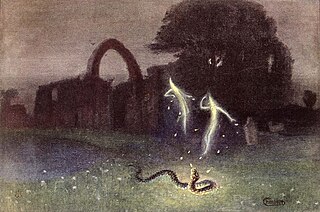
In folklore, a will-o'-the-wisp, will-o'-wisp or ignis fatuus, plural ignes fatui, is an atmospheric ghost light seen by travellers at night, especially over bogs, swamps or marshes. The phenomenon is known in English folk belief, English folklore and much of European folklore by a variety of names, including jack-o'-lantern, friar's lantern and hinkypunk, and is said to mislead travellers by resembling a flickering lamp or lantern. In literature, will-o'-the-wisp metaphorically refers to a hope or goal that leads one on, but is impossible to reach, or something one finds strange or sinister.

A jack-o'-lantern is a carved lantern, most commonly made from a pumpkin or a root vegetable such as a rutabaga or turnip. Jack-o'-lanterns are associated with the Halloween holiday. Its name comes from the reported phenomenon of strange lights flickering over peat bogs, called will-o'-the-wisps or jack-o'-lanterns. The name is also tied to the Irish legend of Stingy Jack, a drunkard who bargains with Satan and is doomed to roam the Earth with only a hollowed turnip to light his way.
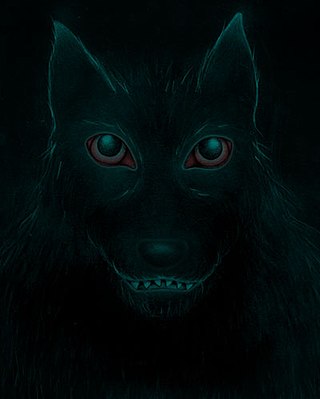
In English folklore, Black Shuck, Old Shuck, Old Shock or simply Shuck is the name given to a ghostly black dog which is said to roam the coastline and countryside of East Anglia, one of many such black dogs recorded in folklore across the British Isles. Accounts of Black Shuck form part of the folklore of Norfolk, Suffolk, the Cambridgeshire Fens and Essex, and descriptions of the creature's appearance and nature vary considerably; it is sometimes recorded as an omen of death, but, in other instances, is described as companionable.

Thomas Lyon-Bowes was the first child of Thomas Lyon-Bowes, Lord Glamis, and his wife Charlotte Lyon-Bowes née Grimstead, great-grandparents of Elizabeth Bowes-Lyon, who became queen consort in 1936. Although Thomas is recorded in Robert Douglas' Peerage of Scotland as "born and died, October 21, 1821," rumours began to circulate during the late 19th century that the child had been born deformed, and had therefore been brought up in seclusion hidden away in Glamis Castle in Angus, Scotland, giving rise to the soubriquet of the Monster of Glamis, or the Horror of Glamis.
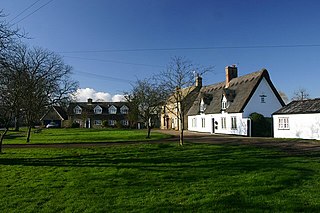
Wicken is a small village on the edge of The Fens near Soham in East Cambridgeshire, ten miles north east of Cambridge and five miles south of Ely. It is the site of Wicken Fen National Nature Reserve.

Swiss folklore describes a collection of local stories, celebrations, and customs of the alpine and sub-alpine peoples that occupy Switzerland. The country of Switzerland is made up of several distinct cultures including German, French, Italian, as well as the Romansh speaking population of Graubünden. Each group has its own unique folkloric tradition.

Spinney Abbey, originally known as Spinney Priory, is a house and farm on the site of a former monastic foundation close to the village of Wicken, on the edge of the fens in Cambridgeshire, England.

Wicken Fen is a 254.5-hectare (629-acre) biological Site of Special Scientific Interest west of Wicken in Cambridgeshire. It is also a National Nature Reserve, and a Nature Conservation Review site. It is protected by international designations as a Ramsar wetland site of international importance, and part of the Fenland Special Area of Conservation under the Habitats Directive.
In the folklore of Cambridgeshire, the Shug Monkey is a creature that shares features of a dog and monkey, which reportedly haunted Slough Hill Lane. The creature, believed to have the body of a jet-black shaggy sheepdog and the face of a monkey with staring eyes, was believed to be a supernatural ghost or demon. Local writer and broadcaster James Wentworth Day, who first related stories of the Shug Monkey in Here Are Ghosts and Witches (1954), described it as a curious variation of Black Shuck, while local folklorist Polly Howat suggests that both share common origins in Norse mythology.

In ghostlore, a ghost train is a phantom vehicle in the form of a locomotive or train. The ghost train differs from other traditional forms of haunting in that rather than being a static location where ghosts are claimed to be present, "the apparition is the entire train".
National Cycle Route 11 is a bikeway in England on the UK's National Cycle Network, connecting Harlow in Essex to King's Lynn in Norfolk.

World Tales, subtitled "The Extraordinary Coincidence of Stories Told in All Times, in All Places" is a book of 65 folk tales collected by Idries Shah from around the world, mostly from literary sources. Some of the tales are very current, others are less well known.

The Cambridgeshire Lodes are a series of man-made waterways, believed to be Roman in origin, located in the county of Cambridgeshire, England. Bottisham, Swaffham Bulbeck, Reach, Burwell, Wicken and Monks Lodes all connect to the River Cam, while Soham Lode connects to the River Great Ouse. All have been navigable historically, but some are no longer officially navigable.
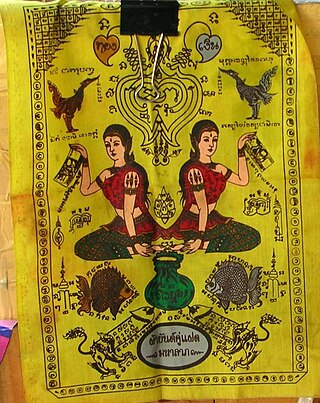
Thai folklore is a diverse set of mythology and traditional beliefs held by the Thai people. Most Thai folklore has a regional background for it originated in rural Thailand. With the passing of time, and through the influence of the media, large parts of Thai folklore have become interwoven with the wider popular Thai culture.
A toadman or toad-man is someone, in the folklore of the Fens of East Anglia and Lincolnshire, who has made a deal with the devil which gives them control over horses. Stories of toadmen seem to have been prevalent in the region during the inter-war period of 1918 to 1938.
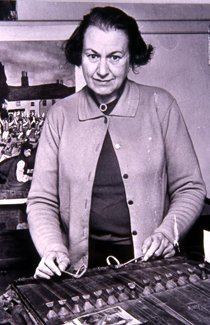
Enid Mary Porter was a collector of folklore in Cambridgeshire and the longest serving curator of the Cambridge & County Folk Museum, now the Museum of Cambridge, working from 1947 to 1976. Her work was invaluable in recording the cultural and social practices of people in Cambridgeshire; she was innovative in the discipline of social history collection, employing working practices such as oral history, and engaging with people in areas that had previously been overlooked by folklorists. Her notebooks, now in possession of the Museum of Cambridge, hold a treasure-trove of information about Cambridgeshire customs, stories and songs.
References
- 1 2 Underwood, Peter (1984), "Wicken Fen, Cambridgeshire", This Haunted Isle, Harrap, ISBN 9780245542329
- 1 2 3 James, Maureen (2014), "Of Strange Phenomena: Black Dogs, Will o' the Wykes and Lantern Men", Cambridgeshire Folk Tales, History Press, ISBN 9780752466286
- 1 2 3 Codd, Daniel (2010), "Inexplicable Incidents, Bizarre Behaviour and Peculiar Places: John Clare's Will-o'-the-Whisps", Mysterious Cambridgeshire, JMD Media, ISBN 9781859838082
- 1 2 3 O'Dell, Damien (15 November 2011), "More Tales from the Fens: Wicken Fen", Paranormal Cambridge, Amberley (published 2011), ISBN 9781848681385